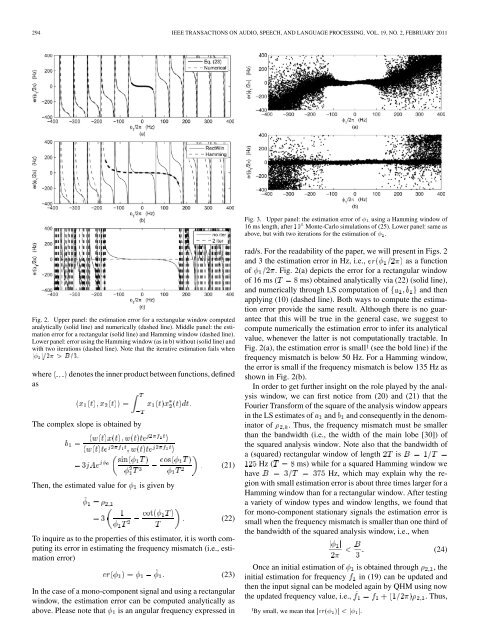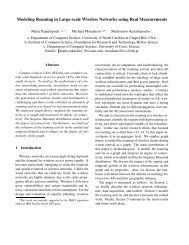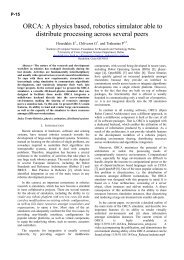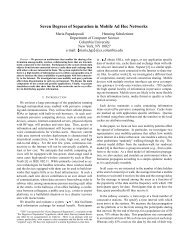Adaptive AM–FM Signal Decomposition With Application to ... - ICS
Adaptive AM–FM Signal Decomposition With Application to ... - ICS
Adaptive AM–FM Signal Decomposition With Application to ... - ICS
You also want an ePaper? Increase the reach of your titles
YUMPU automatically turns print PDFs into web optimized ePapers that Google loves.
294 IEEE TRANSACTIONS ON AUDIO, SPEECH, AND LANGUAGE PROCESSING, VOL. 19, NO. 2, FEBRUARY 2011<br />
Fig. 3. Upper panel: the estimation error of using a Hamming window of<br />
16 ms length, after 10 Monte-Carlo simulations of (25). Lower panel: same as<br />
above, but with two iterations for the estimation of .<br />
Fig. 2. Upper panel: the estimation error for a rectangular window computed<br />
analytically (solid line) and numerically (dashed line). Middle panel: the estimation<br />
error for a rectangular (solid line) and Hamming window (dashed line).<br />
Lower panel: error using the Hamming window (as in b) without (solid line) and<br />
with two iterations (dashed line). Note that the iterative estimation fails when<br />
j j=2 > B=3.<br />
where<br />
as<br />
denotes the inner product between functions, defined<br />
The complex slope is obtained by<br />
Then, the estimated value for<br />
is given by<br />
(21)<br />
(22)<br />
To inquire as <strong>to</strong> the properties of this estima<strong>to</strong>r, it is worth computing<br />
its error in estimating the frequency mismatch (i.e., estimation<br />
error)<br />
(23)<br />
In the case of a mono-component signal and using a rectangular<br />
window, the estimation error can be computed analytically as<br />
above. Please note that is an angular frequency expressed in<br />
rad/s. For the readability of the paper, we will present in Figs. 2<br />
and 3 the estimation error in Hz, i.e., as a function<br />
of . Fig. 2(a) depicts the error for a rectangular window<br />
of 16 ms ( ms) obtained analytically via (22) (solid line),<br />
and numerically through LS computation of and then<br />
applying (10) (dashed line). Both ways <strong>to</strong> compute the estimation<br />
error provide the same result. Although there is no guarantee<br />
that this will be true in the general case, we suggest <strong>to</strong><br />
compute numerically the estimation error <strong>to</strong> infer its analytical<br />
value, whenever the latter is not computationally tractable. In<br />
Fig. 2(a), the estimation error is small 1 (see the bold line) if the<br />
frequency mismatch is below 50 Hz. For a Hamming window,<br />
the error is small if the frequency mismatch is below 135 Hz as<br />
shown in Fig. 2(b).<br />
In order <strong>to</strong> get further insight on the role played by the analysis<br />
window, we can first notice from (20) and (21) that the<br />
Fourier Transform of the square of the analysis window appears<br />
in the LS estimates of and and consequently in the denomina<strong>to</strong>r<br />
of . Thus, the frequency mismatch must be smaller<br />
than the bandwidth (i.e., the width of the main lobe [30]) of<br />
the squared analysis window. Note also that the bandwidth of<br />
a (squared) rectangular window of length is<br />
Hz ( ms) while for a squared Hamming window we<br />
have<br />
Hz, which may explain why the region<br />
with small estimation error is about three times larger for a<br />
Hamming window than for a rectangular window. After testing<br />
a variety of window types and window lengths, we found that<br />
for mono-component stationary signals the estimation error is<br />
small when the frequency mismatch is smaller than one third of<br />
the bandwidth of the squared analysis window, i.e., when<br />
(24)<br />
Once an initial estimation of is obtained through , the<br />
initial estimation for frequency in (19) can be updated and<br />
then the input signal can be modeled again by QHM using now<br />
the updated frequency value, i.e.,<br />
. Thus,<br />
1 By small, we mean that jer( )j < j j.
















